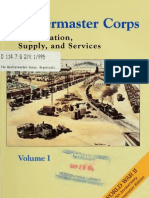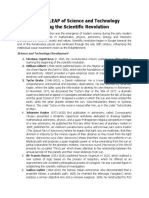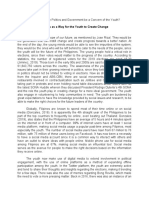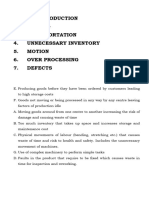LESSON 8 The LEAP of Science and Technology During The Scientific Revolution
LESSON 8 The LEAP of Science and Technology During The Scientific Revolution
Uploaded by
BEATphCopyright:
Available Formats
LESSON 8 The LEAP of Science and Technology During The Scientific Revolution
LESSON 8 The LEAP of Science and Technology During The Scientific Revolution
Uploaded by
BEATphOriginal Title
Copyright
Available Formats
Share this document
Did you find this document useful?
Is this content inappropriate?
Copyright:
Available Formats
LESSON 8 The LEAP of Science and Technology During The Scientific Revolution
LESSON 8 The LEAP of Science and Technology During The Scientific Revolution
Uploaded by
BEATphCopyright:
Available Formats
LESSON 8
The LEAP of Science and Technology
during the Scientific Revolution
(A.D. 1600 - A.D. 1700)
Content Standard:
The learners demonstrate an understanding of the development of Science and
Technology during Scientific Revolution
Learning Outcomes:
The students will be able to:
1. Describe the development of Science and technology during Scientific Revolution;
2. Explicate and recognize the significance of the technology invented during Scientific
Revolution;
3. Recognize and appreciate the works of the different proponents of the Scientific
Revolution period.
Word Bank:
Scientific revolution, magnet, comet, astronomia nova, telescope, gravitation, alchemy,
tabula rasa
DISCUSSION
The scientific revolution was the emergence of modern science during the early
modern period, when developments in mathematics, physics, astronomy, biology and
chemistry transformed the views of society and nature. The scientific revolution began in
Europe towards the end of the Renaissance period and continued through the late 18th
century, influencing the intellectual social movement known as the Enlightenment.
Science and Technology Development:
1. Nicolaus Copernicus in 1543, De revolutionibus orbium coelestium is often cited as
marking the beginning of the scientific revolution.
2. William Gilbert (1544—1603) published books On the Magnet and Magnetic Bodies,
and the Great Magnet the Earth in 1600, which laid the foundations of a theory of
magnetism and electricity. Gilbert provided a hyper-empirical study of magnets,
magnetism, and electricity with speculations about cosmology.
3. Tycho Brahe (1546—1601), a Danish nobleman. He is known for his accurate and
comprehensive astronomical and planetary observations. He was assisted by Johannes
Kepler, where the latter used the information to develop his own theories in Astronomy.
In November 1572, He discovered the 'Tycho'$ Star' or the 'Star of 1572', a dramatic
supernova believed to appear in Cassiopeia constellation which became the talk of
Europe and the great Comet of 1577. Proposed a system in which the sun and moon
orbited the earth, while the other planets orbited the sun. (Geo-Heliocentric theory or
tychonic theory). The crater Tycho on the moon is named after him, as in the crater
Tycho Brahe on Mars.
4. Johannes Kepler (1571—1630) first publication in astronomy, called Cosmographic
Mystery presented a stridently Copernican worldview dedicated to drawing together
mathematical astronomy, physics, and a quasi-Pythagorean religious perspective in
hope of a new astronomy; He published the first two of his three laws of planetary motion
in 1609; published his Ad vitellioem paralipomena quibus astronomiae pars optica
traditor (The Optical Part of Astronomy) where he argues that light rays are rectilinear,
that they diminish in intensity by the inverse square of their distance as they travel from
the light source; Astronomia nova (New Astronomy) shows that Mars moves non-
uniformly in an elliptical path and proposes a quasi-magnetic power or virtue emanating
from the sun as partial explanation for the planetary motions; Harmonice mundi
(Harmonies of the World) presents his so-called 'Third Law' which draws attention to the
relationship between the annual periods of the planets and their mean distances from
the sun.
5. Sir Francis Bacon (1561—1626) published Novum Organum in 1620, which outlined a
new system of logic based on the process of reduction, which he offered as an
improvement over Aristotle's philosophical process of syllogism. He was a pivotal figure
in establishing the scientific method of investigation.
6. Galileo Galilei (1564—1642) the famous Italian Astronomer who demonstrated that a
projectile follows a parabolic path; 1608, he invented the telescope ('spyglass') which
employs a convex objective lens and a concave eyepiece; 1609, he constructed his
first telescope and turns it toward the heavens and able to discover and argues there
are innumerable stars invisible to the naked eye; He discovered mountains on the Moon
and four moons circling Jupiter; later in 1610, Galileo observes the phases of Venus,
which suggested to him that waning and waxing planet must circle the Sun; discovered
the sunspots; noted that Saturn appeared to have 'handles' and troubled over what could
give rise to such an appearance; 1616, the year of the infamous Injunction against
Galileo, was warned by the Inquisition not to hold or defend the hypothesis asserted in
Copernicus' On the Revolutions, though it has been debated whether he was
admonished not to 'teach in any way' the heliocentric theory. This work was in turn
placed on the Index of Prohibited Books until corrected.
7. René Descartes (1596—1650) published his Discourse on the Method in 1637, which
helped to establish the scientific method.
8. Antoine van Leeuwenhoek (1632—1723) constructed powerful single lens
microscopes and made extensive observations that he published around 1660, opening
up the micro-world of biology.
9. Isaac Newton (1643—1727) built upon the work of Kepler and Galileo. He showed that
an inverse square law for gravity explained the elliptical orbits of the planets, and
advanced the law of universal gravitation; In his Principia, Newton theorized his
axiomatic three laws of motion.
10. Alexandre Koyré, in the 20th century, introduced the term "Scientific Revolution",
centering his analysis on Galileo, and the term was popularized by Butterfield in his
Origins of Modern Science.
11. John Locke is recognized founder of empiricism and proposed in An Essay Concerning
Human Understanding (1689) that the only true knowledge that could be accessible to
the human mind was that which was based on experience. He argued that the human
mind was created as a tabula rasa, a "blank tablet," upon which sensory impressions
were recorded and built up knowledge through a process of reflection.
12. Robert Boyle (1627—1691) an English chemist considered to have refined the modern
scientific method for alchemy and to have separated chemistry further from alchemy.
Boyle is largely regarded today as the first modern chemist, and therefore one of the
founders of modern chemistry, and one of the pioneers of modern experimental scientific
method. Although Boyle was not an original discover, he is best known for Boyle's Law,
which he presented in 1662: the law describes the inversely proportional relationship
between the absolute pressure and volume of gas, if the temperature is kept constant
within a closed system. He built an Air pump and many new instruments were devised
in this period, which greatly aided in the expansion of scientific knowledge.
13. Refracting telescopes first appeared in the Netherlands in 1608. The spectacle makers
Hans Lippershey, Zacharias Janssen and Jacob Metius of Alkmaarall contributed to
its invention.
14. Evangelista Torricelli (1607—1647) was best known for his invention of the mercury
barometer. The motivation for the invention was to improve on the suction pumps that
were used to raise water out of the mines.
DO YOU KNOW?
SIR ISAAC NEWTON (1642-1727). English physicist, mathematician, and natural
philosopher, considered one of the most important scientists of all time. Newton formulated
laws of universal gravitation and motion—laws that explain how objects move on Earth as
well as through the heavens.
Newton's first law of motion states that if the vector sum of the forces acting on an
object is zero, then the object will remain at rest or remain moving at constant velocity. The
Law of Inertia.
Newton's second law relates to net force and acceleration. A net force on an object
will accelerate it—that is, change its velocity. The acceleration will be proportional to the
magnitude of the force and in the same direction as the force. The Law of acceleration.
Newton's third law of motion states that an object experiences a force because it is
interacting with some other object. The force that object 1 exerts on object 2 must be of the
same magnitude but in the opposite direction as the force that object 2 exerts on object 1.
The Law of Interaction.
Newton's Law of Universal Gravitation. The pull of the Earth on objects at its surface
is its pull of gravity.
You might also like
- Theory of Magnetism and Electricity. Magnets, Magnetism, and Electricity CosmologyDocument3 pagesTheory of Magnetism and Electricity. Magnets, Magnetism, and Electricity CosmologyJunna Marie DiosesNo ratings yet
- Copernicus and Kepler: A New View of The Universe: Geocentric TheoryDocument8 pagesCopernicus and Kepler: A New View of The Universe: Geocentric Theoryapi-287069252No ratings yet
- The Quartermaster Corps Organization, Supply, and Services Volume I CMH Pub 10-12-1Document440 pagesThe Quartermaster Corps Organization, Supply, and Services Volume I CMH Pub 10-12-1Paul D Carrier100% (1)
- Lesson 8: The LEAP of Science and Technology During The Scientific RevolutionDocument3 pagesLesson 8: The LEAP of Science and Technology During The Scientific RevolutionChristian Jay CusayNo ratings yet
- Module 9Document4 pagesModule 9bayoterica39No ratings yet
- Science Technology and Society Lesson 8Document8 pagesScience Technology and Society Lesson 8eloisaannjewelromano.bascNo ratings yet
- Discussion: Mystery Presented A Stridently Copernican Worldview Dedicated To Drawing TogetherDocument3 pagesDiscussion: Mystery Presented A Stridently Copernican Worldview Dedicated To Drawing TogetherjunjurunjunNo ratings yet
- The LEAP of Science and Technology During The Scientific Revolution (A.D. 1600-A.D. 1700)Document14 pagesThe LEAP of Science and Technology During The Scientific Revolution (A.D. 1600-A.D. 1700)Ramses MalalayNo ratings yet
- Scientific Revolution: LESSON 8: The LEAP of Science and Technology During Scientific RevolutionDocument5 pagesScientific Revolution: LESSON 8: The LEAP of Science and Technology During Scientific Revolutionlagunoyaira24No ratings yet
- Technology and Science of 17-18th CenturyDocument14 pagesTechnology and Science of 17-18th CenturyJayden CalpitoNo ratings yet
- The Scientific Revolution - History Assignment - Yousuf Chaudhry, Eshaal Mansuri, Daliah AshrafDocument30 pagesThe Scientific Revolution - History Assignment - Yousuf Chaudhry, Eshaal Mansuri, Daliah Ashrafyousufchoudhry4No ratings yet
- Science and TechnologyDocument3 pagesScience and TechnologySandara ZacariaNo ratings yet
- Astronomy: Copernicus, Kepler, Galileo, Newton, and LeibnizDocument5 pagesAstronomy: Copernicus, Kepler, Galileo, Newton, and LeibnizcheyeenNo ratings yet
- Scientific Revolution PPT Accompanying Lecture 2019 UpdatedDocument21 pagesScientific Revolution PPT Accompanying Lecture 2019 UpdatedjhbomNo ratings yet
- Sts-Topic1 ModuleDocument3 pagesSts-Topic1 Moduleshammahadelie1612No ratings yet
- Gross Facts about the Renaissance Scientists | Children's Renaissance HistoryFrom EverandGross Facts about the Renaissance Scientists | Children's Renaissance HistoryNo ratings yet
- The Scientific RevolutionDocument10 pagesThe Scientific RevolutionMegha ChaudharyNo ratings yet
- S&s Notes and Mcq'sDocument91 pagesS&s Notes and Mcq'sJoshua JacksonNo ratings yet
- Science RevolutionDocument9 pagesScience RevolutionMark Jeso BadanoyNo ratings yet
- Physics Theory13Document6 pagesPhysics Theory13StewHankWlakerNo ratings yet
- Physics in 17th CenturyDocument17 pagesPhysics in 17th CenturyFrancis CorrosNo ratings yet
- Lesson 8 - STS 100 - During Scientific RevolutionDocument4 pagesLesson 8 - STS 100 - During Scientific RevolutionJuren LasagaNo ratings yet
- Intellectual Revolutions That Defined SocietyDocument20 pagesIntellectual Revolutions That Defined SocietydasalchinNo ratings yet
- 3 Intellectual RevolutionsDocument38 pages3 Intellectual Revolutionsdaneflor00No ratings yet
- Revised Copernican Rev.Document15 pagesRevised Copernican Rev.Jamille Irish MercaderoNo ratings yet
- Scientific Revolution and Enlightenment NotesDocument69 pagesScientific Revolution and Enlightenment NotesPatricia andreah MeñezNo ratings yet
- The Scientific RevolutionDocument3 pagesThe Scientific Revolutionapi-508882599No ratings yet
- 3 Sem Bcom - Science and SocietyDocument90 pages3 Sem Bcom - Science and SocietyBhavana Prakash100% (1)
- Revolutions of The Heavenly Spheres in 1543, The Same YearDocument4 pagesRevolutions of The Heavenly Spheres in 1543, The Same YearAsh HassanNo ratings yet
- Lesson Plan 1.3Document11 pagesLesson Plan 1.3Laurel S. MedinaNo ratings yet
- The History of Science, Technology and Intellectual Revolutions That Defined SocietyDocument6 pagesThe History of Science, Technology and Intellectual Revolutions That Defined SocietyJerome LegaspiNo ratings yet
- Quiz No. 6Document3 pagesQuiz No. 6BEATphNo ratings yet
- Universe and Its Worlds The Renegade Italian Monk Unfolds His Philosophy, The Centerpiece of Which Is The Contention That TheDocument3 pagesUniverse and Its Worlds The Renegade Italian Monk Unfolds His Philosophy, The Centerpiece of Which Is The Contention That TheEzekiel AlmadronesNo ratings yet
- Science Research PaperDocument3 pagesScience Research Paperlaylalawson07No ratings yet
- Astronomers and How They Shaped AstronomyDocument36 pagesAstronomers and How They Shaped AstronomySay KhoNo ratings yet
- Name 10 Individual Scholars and Their Great Works StudyDocument2 pagesName 10 Individual Scholars and Their Great Works StudyHerdy R. DimanligNo ratings yet
- The LEAP of Science and Technology During Scientific RevolutionDocument16 pagesThe LEAP of Science and Technology During Scientific RevolutionEmgelle JalbuenaNo ratings yet
- The Evolution of PhysicsDocument17 pagesThe Evolution of PhysicsYtle08No ratings yet
- A Brief History of ScienceDocument2 pagesA Brief History of SciencelucabezdikNo ratings yet
- Sciensctist ChartDocument4 pagesSciensctist ChartWillSmithNo ratings yet
- Origin and History of PhysicsDocument7 pagesOrigin and History of PhysicsScribdTranslationsNo ratings yet
- Timeline History of ScienceDocument6 pagesTimeline History of ScienceMatara Ligaya GarciaNo ratings yet
- The Scientific Revolution (Assignment - Alina Becali)Document6 pagesThe Scientific Revolution (Assignment - Alina Becali)Ioan NaturaNo ratings yet
- Contribution and Postulate of Famous AstronomersDocument2 pagesContribution and Postulate of Famous AstronomersRj YanesNo ratings yet
- 2nd Grading Activity No. 2 Science 9Document4 pages2nd Grading Activity No. 2 Science 9Jessa EspirituNo ratings yet
- Revolution of ScineceDocument9 pagesRevolution of Scinecemoveena abdullahNo ratings yet
- The 16th Century Revolution in ScienceDocument32 pagesThe 16th Century Revolution in ScienceJohn OsborneNo ratings yet
- Scientific Revolution and EnlightenmentDocument3 pagesScientific Revolution and Enlightenmentpriyatiyagi14No ratings yet
- Scientific RevolutionDocument22 pagesScientific Revolutiontheodore baiNo ratings yet
- Isaac NewtonDocument5 pagesIsaac Newtonapi-270467511No ratings yet
- STS Outline Chap.2Document6 pagesSTS Outline Chap.2kevin funtallesNo ratings yet
- Brief History of PhysicsDocument14 pagesBrief History of PhysicsScribdTranslationsNo ratings yet
- Scientific RevolutionDocument2 pagesScientific RevolutionSanchari Das100% (1)
- Scientists and Their ContributionsDocument13 pagesScientists and Their ContributionsBook WormNo ratings yet
- The Development of PhysicsDocument27 pagesThe Development of PhysicsngthuthuyNo ratings yet
- Scientific RevulotionDocument29 pagesScientific RevulotionJohn Paul P CachaperoNo ratings yet
- Physics: Physik (Epist M) PhýsisDocument7 pagesPhysics: Physik (Epist M) PhýsisGrim WarriorNo ratings yet
- Sciteso PPTDocument72 pagesSciteso PPTCharles NavarroNo ratings yet
- STS 1Document7 pagesSTS 1Jolie Mar ManceraNo ratings yet
- 20 Physicists Who Revolutionised Our Understanding of The WorldDocument7 pages20 Physicists Who Revolutionised Our Understanding of The WorldChincel AniNo ratings yet
- Johannes Kepler - Including a Brief History of Astronomy and the Life and Works of Johannes Kepler with Pictures and a Poem by Alfred NoyesFrom EverandJohannes Kepler - Including a Brief History of Astronomy and the Life and Works of Johannes Kepler with Pictures and a Poem by Alfred NoyesNo ratings yet
- CorrectionDocument26 pagesCorrectionBEATphNo ratings yet
- SURVEYING REPORT_Jerson_061239Document37 pagesSURVEYING REPORT_Jerson_061239BEATphNo ratings yet
- Lesson 4 The Contributions of Arabs, Chinese and Hindu in The Development of Science and TechnologyDocument8 pagesLesson 4 The Contributions of Arabs, Chinese and Hindu in The Development of Science and TechnologyThaddeus MuncadaNo ratings yet
- Filipino Values and Culture ThesisDocument42 pagesFilipino Values and Culture ThesisBEATphNo ratings yet
- Magnet1 1Document11 pagesMagnet1 1a.mahdieh90No ratings yet
- The Rizal MonumentDocument1 pageThe Rizal MonumentGinalyn ArzobalNo ratings yet
- West Bengal Government and SocietyDocument10 pagesWest Bengal Government and SocietyMadhuNo ratings yet
- RPH ReviewerDocument44 pagesRPH ReviewerHoneycris AguilarNo ratings yet
- Pestle Analysis of MaggiDocument7 pagesPestle Analysis of Maggitapan mistryNo ratings yet
- Book Chapter BiosurfactantDocument5 pagesBook Chapter BiosurfactantDipti MehraNo ratings yet
- Assignment ACT201 SMR1Document15 pagesAssignment ACT201 SMR1Md.sabir 1831620030No ratings yet
- Assignment On Ion Exchange in Soil: Instructor: Student: Id: Section: SemesterDocument4 pagesAssignment On Ion Exchange in Soil: Instructor: Student: Id: Section: SemesterUsman GhaniNo ratings yet
- Monash South Africa: Chibisa Walter KudzaiDocument2 pagesMonash South Africa: Chibisa Walter KudzaiStan StansNo ratings yet
- Pox VirusDocument8 pagesPox VirusDayana PrasanthNo ratings yet
- EAPP Position PaperDocument6 pagesEAPP Position PaperAudreyNo ratings yet
- Alana - Ac301 - Reflection PaperDocument1 pageAlana - Ac301 - Reflection Paperkate trishaNo ratings yet
- CV - Sistemas HFG InglesDocument5 pagesCV - Sistemas HFG InglesheraldofabiangiampaoloNo ratings yet
- Hamlet AllusionsDocument22 pagesHamlet AllusionsRaymoondoh Yuan100% (1)
- Lean ProductionDocument4 pagesLean ProductionmichaeljonescaieNo ratings yet
- Applied Ecology and Natural Resource Management: Guy R. McphersonDocument19 pagesApplied Ecology and Natural Resource Management: Guy R. McphersonJoyce GeorgeNo ratings yet
- Tarrow Democracy and Disorder ExcerptsDocument6 pagesTarrow Democracy and Disorder ExcerptsdivadnotnaNo ratings yet
- ACTG 431 QUIZ Week 3 Theory of Accounts (Part III) PROPERTY, PLANT AND EQUIPMENT QUIZDocument6 pagesACTG 431 QUIZ Week 3 Theory of Accounts (Part III) PROPERTY, PLANT AND EQUIPMENT QUIZMarilou Arcillas PanisalesNo ratings yet
- Efficient Management of Information Communication Technology Resources in An OrganisationDocument19 pagesEfficient Management of Information Communication Technology Resources in An Organisationeyob yohannesNo ratings yet
- Personal StatementDocument1 pagePersonal Statementolamide.odukunleNo ratings yet
- Barrett Beyond Psychometrics 2003 AugmentedDocument34 pagesBarrett Beyond Psychometrics 2003 AugmentedRoy Umaña CarrilloNo ratings yet
- Srihari ETLDocument4 pagesSrihari ETLChirantar KumarNo ratings yet
- WritingDocument101 pagesWritingdf_campos3353100% (3)
- Trinidad Tobago Ngo Directory April 2018 Download VersionDocument64 pagesTrinidad Tobago Ngo Directory April 2018 Download VersiondanieltonihughesNo ratings yet
- HRT Treatment Options Feb 2022 FinalDocument3 pagesHRT Treatment Options Feb 2022 FinalQusaiBadrNo ratings yet
- The Efficient Market HypothesisDocument2 pagesThe Efficient Market HypothesisMuhammad AbdullahNo ratings yet
- Rhomel Mark S. Labor: Position Applied: WelderDocument6 pagesRhomel Mark S. Labor: Position Applied: WelderRhomel Mark LaborNo ratings yet
- David Hughes - Omniwar PresentationDocument63 pagesDavid Hughes - Omniwar PresentationRudy Tatang Raja Braimon SidabutarNo ratings yet
- The Great Pyramid of Giza Built 4700 BC In: Golden Ratio in ArchitectureDocument3 pagesThe Great Pyramid of Giza Built 4700 BC In: Golden Ratio in ArchitectureJohn Luis BantolinoNo ratings yet





























































































